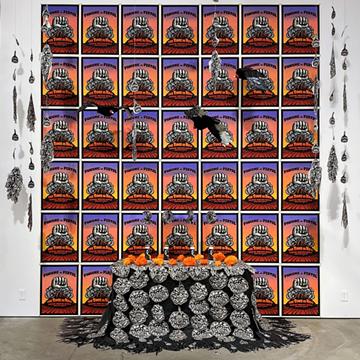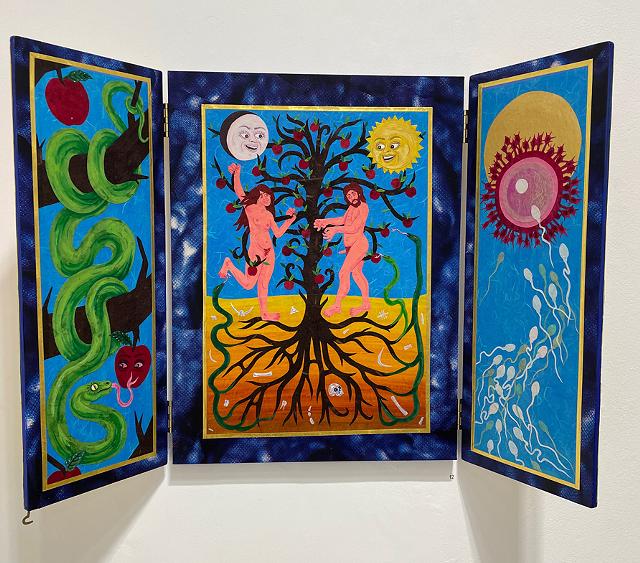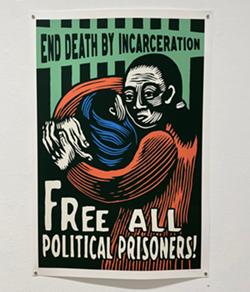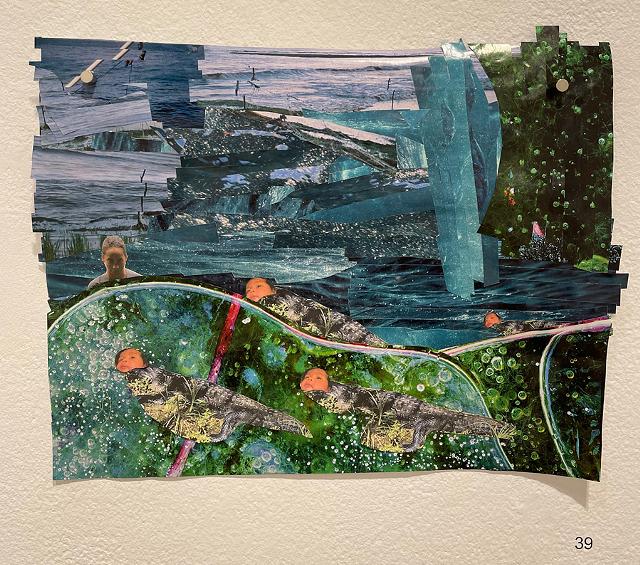
- PHOTO PROVIDED
- Kill Joy's "2020" installation at Rochester Contemporary Art Center envisions that eruptive year as a portal to positive change.
This is an underlying concept in Rochester Contemporary’s current show, “A Change is Coming,” which features the work of three contemporary printmakers sounding the alarm on issues ranging from environmental concerns to racism and our relationship to our bodies.
The idea of actively participating in positive change is perhaps most obviously found in the work of South Korea-born Mizin Shin, a professor at the University of Rochester. Her “Use Your Voice: Stop Asian Hate” project is displayed as rows of eye-catching street sign-like posters that spell out “Use Your Voice” in 18 alternating languages — each with #STOP ASIAN HATE in English at the bottom.
While Shin’s project is monumental in scope, it’s a stark and simple message, created in response to rising incidences of violence against Asians and Asian Americans as well as anti-Asian rhetoric.
And while several Asian languages are included in the translations, it was important to the artist that non-Asian languages were also represented.
“That's really the core of this project, to point out that, though this issue may not personally affect you, it's still up to you to use your voice,” said RoCo’s Executive Director Bleu Cease.
The creation of these posters are an act of disseminating the message. Shin hosts workshops in which volunteers who help print the images can take them and post in public. The next workshop is scheduled at RoCo from 1 to 3 p.m. on Saturday, the closing date of the exhibition.
St. Louis, Missouri-based artist Julia Curran’s work is playfully grotesque and grapples with what she says “it means to be in touch with one’s body in a disembodied culture, our presumption of agency over flesh, and the interconnectedness of our internal and shared environments.”

- PHOTO BY REBECCA RAFFERTY
- Julia Curran's mixed-media works explore our complicated relationships to our bodies and nature.
Certain pieces allude to seemingly universal experiences and ailments of having a body, or widely-experienced sentiments, such as “Memento Mori for Evil Men (One Day You Too Will Die, She Will Eat You, Then Shit Out Your Bones),” which depicts a wild, blue, underworldly giantess of vengeance literally doing all of the above.
But each of the pieces are born from something she has borne.
“My work draws from personal histories of shame and unsightly symptoms, navigating a broken healthcare system — literally on steroids — and eventually finding my way back into my body,” Curran says.
The work of Philippine American and Texas-based artist Kill Joy visually harkens back to traditional protest posters specifically in Latin America with its bold-text slogans and high contrast illustrations. At RoCo it’s presented both as single posters in support of various environmental and social concerns, such as destructive pipelines and political prisoners.
“End Death by Incarceration” is a depiction of Philippine dissident Amanda Echanis, who took up her father’s work after he was tortured and murdered. She was arrested in late 2020 while in her third trimester of pregnancy, and was forced to give birth in handcuffs. Kill Joy has illustrated her holding her swaddled son, with whom she is incarcerated.
Rows of Kill Joy’s posters, often created in collaboration with grassroots groups, speak against digging up fossil fuels, corporate greed, the killing of peasant farmers, and fascist dictatorships, while others praise Indigenous activism, and traditional ways of living in balance with the Earth.
Most are printed using earthy-toned inks and bright primary colors, with the exception of “Healing.” Printed with black ink on a shiny, prismatic surface, the work in four panels assures viewers that crying, prayer, creating, and laughter are all powerful medicines.

- PHOTO BY REBECCA RAFFERTY
- A print by Kill Joy that depicts Philippine dissident Amanda Echanis, who is incarcerated with her baby son.
One block of woodcut prints simply depict the stark violence of volcanic eruptions, which the artist uses to symbolize the social upheaval of 2020, as many long-brewing issues were pushed into the mainstream. Kill Joy has visited each of the volcanoes depicted and named in this set.
These veins of thought in Kill Joy’s work culminates in the back of the gallery space, in a massive volcanic installation titled “2020.” Forty wall-mounted prints repeat the phrases “Pandemic as Portal,” “The Time Is Now,” and “Imagine Another World and Fight For It,” superimposed on a volcano with a fist rising out of its explosion.
In front of that wall is an altar that displays devotional candles and paper flowers. Prints that resemble both plumes of ashes and blossoms are suspended from the ceiling, raining down around papier mache vultures on the wing. The volcanoes signify change, while the ashes stand for fertilizer for new life, according to the statement.
“The times gave way for an explosion of energy that propelled us to a possible portal where we could choose to pass through,” Kill Joy’s statement reads. “Just like the erupting volcano with spewing ash that lays the foundation for new growth, so can be the lessons we learned from the clear vision year of 2020.”
In the LAB Space
Don’t overlook Erica Bryant’s “40/40 Visions,” which is tucked away in RoCo’s member gallery, the LAB Space. When she turned 40, the former Democrat and Chronicle columnist embarked on a challenge to create 40 collages that explore 40 dreams (hers and those shared with her by friends), translating the strange world of the subconscious into seriously engaging images.
Take, for instance, “Heads at the Lake.” This wonderful little creation has pairs of children standing shin-deep in ribbons of paper tide under a sparkling pink and orange sky, each reaching for the other's face. The description that comes with this piece matter-of-factly states, “Every morning people go to Lake Ontario to exchange heads.”

- PHOTO BY REBECCA RAFFERTY
- "Baby Alligators," a collage by Erica Bryant, is based on a dream in which the artist was the spiritual leader of alligators with human baby heads.
A school of baby-headed reptiles peacefully swim amid underwater greenery. A high-five from Lizzo. A mother with claws for hands. A father fixing the stars.
There’s little explanation for each of the pictures — all that’s offered is a single line, which ranges from absurd to quietly profound. But somehow that’s all that's needed.
Whatever Bryant got from this little exercise, it’s satisfying and somewhat soothing to be afforded a peek into someone else’s bizarre internal escapades for once.
“A Change is Coming” and “40/40 Vision” continue through Saturday. Rochester Contemporary is open Wednesday through Sunday, noon to 5 p.m., and Friday, noon to 9 p.m.
Rebecca Rafferty is CITY’s life editor. She can be reached at [email protected].
